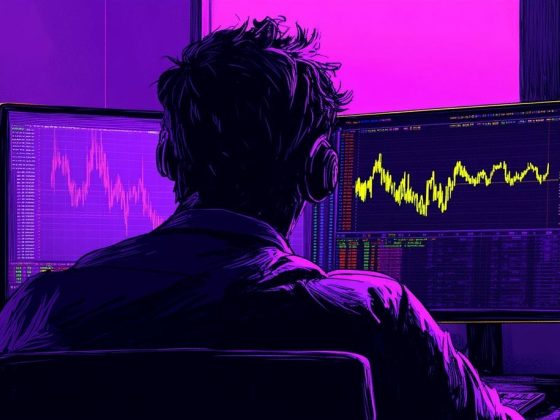Key Takeaways:
Bitcoin might be on the verge of a massive breakout, according to market analysts. The BTC price could rise to $125,000 if Donald Trump wins the U.S. presidential election, they say. Other macroeconomic factors, such as Federal Reserve policies and global liquidity, could impact the Bitcoin price.Many believe that Bitcoin (BTC) is on the verge of a massive breakout, signaling the start of a bull market. Analyst Crypto Rover even gave an exact timeframe of when this “bull run” will start: Sept. 30 to Oct. 4.
His predictions are based on historical BTC price performances following an event that happens every four years, known as the “Bitcoin halving,” which reduces the amount of Bitcoin entering circulation.
On Sept. 26, the price of Bitcoin broke through the psychological $65,000 mark. Hours later on X, Crypto Rover declared: “Bitcoin bull market begins now,” which was a few days earlier than his initial predictions.
Many people in the crypto sector share the analyst’s optimism. So, how can you know the Bitcoin bull market—a period that might push BTC to new record highs—has started? We look at some of the indicators that could point to a sustained surge in the price of Bitcoin.
What Is a Bull Market?
Put simply, a bull market, or a bull run, is a rising market, typically over an extended period. Prices of assets such as stocks, real estate, or cryptocurrency quickly skyrocket as investors buy more of the assets.
A 20% price increase is generally accepted as a sign that the market is moving into a bullish phase. Supply shortages also mark bull markets as demand rises, and investor confidence is often very high.
In bear markets, the opposite is true for all of the above factors. Bear markets are characterized by a prolonged downtrend, falling volumes, sustained price drops, and negative sentiment across the board.
“It’s important to watch out for these trends to better understand where we are in the market cycle,” David Nikzad, co-founder of Bitcoin-based decentralized exchange and NFT platform DeFi.Gold told Cryptonews.
How Do You Know that Bitcoin Is in a Bull Market?
Like the analyst Crypto Rover, Nikzad believes that “Bitcoin appears to be on the brink of a bull market.”
He said that historically, Bitcoin tends to rally 150-170 days after its halving event, “and we are currently within that critical window.” Previous patterns suggest that the BTC price reached a peak 480 days after the halving.
Bitcoin last halved on April 19, 2024, resulting in the bonus paid to miners – the people who help secure the Bitcoin blockchain – falling by half to 3.125 BTC. The final halving is expected to take place 115 years from now, at which point the number of BTC in circulation will reach its maximum 21 million supply.
Nikzad said some of the major indicators that “we are transitioning into a bull market include breaking key resistance levels, increased trading volumes, and growing market optimism which drives people to buy in.”
For Ryan Lee, chief analyst at Bitget Research, the criteria for defining a Bitcoin bull market may not be so straightforward.
However, if this is based on short-term momentum indicators or technical patterns such as “Moving Average crossover or continuous breakthrough of resistance levels,” then a bull run is in play, he said.
Speaking to Cryptonews, Lee said the real bull run will start when Bitcoin breaks through key resistance at $70,000 with strong volume and stays above this level.
The Bitget chief analyst noted that while short-term indicators may point to a bullish scenario, it is crucial to consider wider market conditions that could disrupt or aid Bitcoin markets. It includes macroeconomic factors such as U.S. Federal Reserve policies, global liquidity trends, and others. Lee said:
“Given that the market is still influenced by these macro factors, I suggest remaining cautious until Bitcoin shows sustained upward momentum in a few weeks and breaks through significant resistance levels.”
Analyst: ‘Bitcoin Is Already in a Bull Market’
Bitcoin is starting to show some bullish signs. On Sept. 27, BTC topped $66,000 for the first time in two months. It came after U.S. headline PCE inflation – which measures changes in prices that consumers pay for goods and services – for August came in lower-than-expected at 2.2% year-on-year. Economists were looking for a rate of 2.3%.
The inflation miss is driving speculation that the Federal Reserve will effect a larger interest rate cut at its next meeting on Nov. 7 to stop the economy from slipping into recession in 2025. According to the CME Fed Watch Tool, traders estimate a 42.9% chance of a 50 basis points rate cut. Lower interest rates are usually bullish for BTC.
Other factors are pushing the Bitcoin price. One is the U.S. Securities and Exchange Commission’s recent approval of listing options on BlackRock’s iShares Bitcoin Trust spot ETF. The move is expected to boost liquidity in Bitcoin markets, giving investors new ways to speculate on movements in the BTC price.
Since early September, Bitcoin is up over 10% and is widely expected to trend even higher in October, a month that has historically been favorable for the asset. Year-to-date, Bitcoin has soared more than 140% and 220% over the past two years.
Mason Jappa, CEO of U.S.-based Bitcoin miner Blockware, said the data is a clear indication that “Bitcoin is already in a bull market.” He told Cryptonews:
“When assessing ‘Is this a bull or bear market?’, narratives and market sentiment are mostly irrelevant. What matters above all else is simply price performance – and Bitcoin has been outperforming.”
Georgii Verbitskii, former managing director at eToro Russia, said the Bitcoin market is considered bullish when it quickly starts reaching new all-time highs on the price chart.
However, “this is not the case so far,” he told Cryptonews. That’s because while BTC is approaching the previous all-time high, it still cannot break the resistance level of $70,000. As of writing, Bitcoin had fallen below $65,000 again, down over 1% in 24 hours.
Verbitskii, who is also the founder of DeFi time-limit order protocol TYMIO, expects Bitcoin to rise sharply in the last three months of 2024 based on past Q4 performances. Barring any “economic corrections,” he is targeting a price of $100,000 by the end of December.
His predictions dovetail with Bitcoin options interest, which “has been building mostly around the round figure of $100,000,” Geoffrey Kendrick, head of crypto research at Standard Chartered, told Forbes.
Kendrick expects that Bitcoin will climb to $125,000 if Donald Trump, who has suddenly become pro-crypto, wins the U.S. presidential election in November. Should Kamala Harris win, the price will rise to $75,000, he says.
Jad Comair, founder and CEO of Melanion Capital, said, “It is very hard to predict” the Bitcoin bull market phase.
“People tend to speculate a lot when it comes to crypto, and I believe investors should consider Bitcoin a long-term play and not focus on short-term gains or catalysts,” the Paris-based hedge fund manager told Cryptonews on LinkedIn.
Market Sentiment Rises, but Retail Interest Declines
According to Lee, the Bitget Research chief analyst, Bitcoin’s bull market status can be measured through some of the following indicators:
Higher highs and higher lows: Bitcoin consistently forms higher highs and higher lows during pullbacks, signaling upward momentum. Moving averages: A bullish trend is often indicated when the 50-day moving average crosses above the 200-day moving average. Increased trading volume: Strong buying activity and significant volume increases typically accompany bull markets. Market sentiment: High investor confidence, driven by news of increased adoption, partnerships, and regulatory clarity, reflects a bullish outlook. On-chain metrics: Indicators such as a growing number of long-term holders and decreased exchange balances suggest holders are unwilling to sell.In a bear market, the reverse of all the factors mentioned above applies. As far as market sentiment is concerned, the numbers aren’t looking so positive. According to data analysis platform Alphractal, sentiment on X and in the news media “is turning highly optimistic again, but [retail] interest in cryptocurrencies is falling to low levels.”
Searches for cryptocurrency and Satoshi Nakamoto, the pseudonymous Bitcoin founder, have returned to levels seen during bear markets, Alphractal posted on X. “This could be a sign that true euphoria hasn’t arrived yet,” the analysts wrote.
Reddit comments on crypto have fallen to their lowest levels since 2021, with a few hundred comments per day. Bitcoin searches have slumped to bear market lows, and engagement is down around 80% since 2021, per global Google Trends data.
“…previous interest was strongly linked to game coins, meme coins, DeFi, and new dApps innovations. Nowadays, many of these solutions no longer feel like novelties, which contributes to reduced interest,” Alphractal noted. “[But] the lack of public interest is more related to Altcoins than Bitcoin itself.”
While Reddit and Google Trends data shows declining retail interest, the Bitcoin Fear and Greed Index, which measures market sentiment, is flashing 61, pointing to “greed.” Bull markets tend to make investors greedy.
“It’s crucial to closely monitor price movements and overall market dynamics to confirm this [bullish] shift, always take profits when the opportunity arises, and stay off the leverage,” Nikzad, the DeFi.Gold co-founder, cautioned.
How Long Does a Bitcoin Bull Market Last?
There seems to be no consensus on how long the Bitcoin bull run lasts. Jappa, the Blockware CEO, explained that historically, Bitcoin is in a bear market for one year out of each halving cycle, and a bull market for the other three years.
But it “often requires hindsight before there is a broad recognition of the exact moment the market shifts from one phase to the other,” he added.
For example, Jappa said in early 2022, Bitcoin was in a bear market. But at the time, the euphoria of the 2021 highs, when BTC peaked at $69,000 in November, “had many investors believing it was still a bull market.”
Bitget’s Lee said the Bitcoin bull market usually lasts for several months to more than a year. He pointed to the bull run of 2020 -2021, saying it lasted from the second half of 2020 to the end of 2021.
“The bull market often coincides with the larger cycle of Bitcoin’s four-year halving cycle, and the decrease in supply is usually the catalyst for price increase,” he detailed.
Nikzad said BTC bull markets last between 12 to 18 months, while bear markets often extend for longer periods, sometimes over two years.
The post Is Bitcoin Entering a Bull Phase? Here’s How to Identify the Signs appeared first on Cryptonews.


